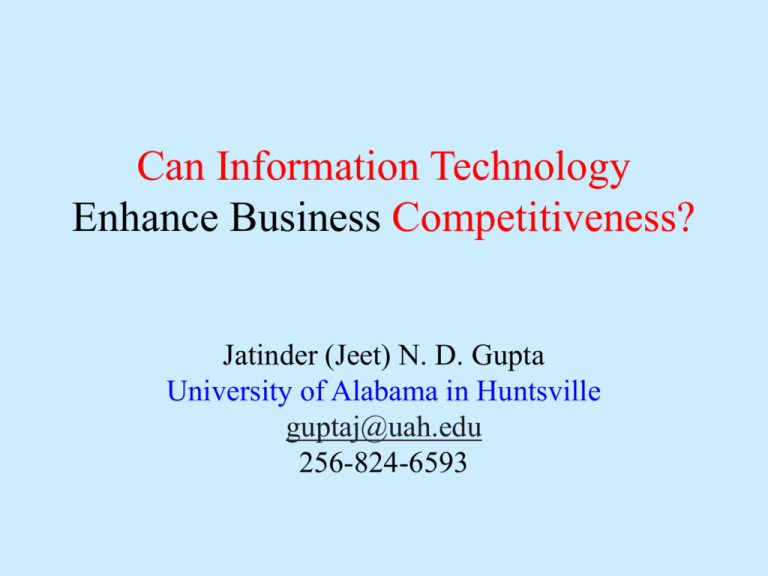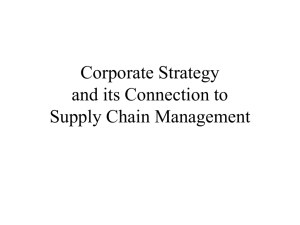Here
advertisement

Can Information Technology Enhance Business Competitiveness? Jatinder (Jeet) N. D. Gupta University of Alabama in Huntsville guptaj@uah.edu 256-824-6593 Quiz A box of cereal spends ? days in the supply chain. • A box of cereal spends 104 days in the supply chain. Total inventory in the pharmaceutical supply chain exceeds ? days and ? $ in savings to be realized. • Total inventory in the pharmaceutical supply chain exceeds 100 days with at least $ 11 billion in savings realized. Quiz (continued) Poor coordination in the food industry supply chain wasted ? dollars. • Poor coordination wasted $ 30 billion annually in the food industry. Boeing wrote-off ? dollars in 1997 due to supply chain inefficiencies. • Boeing wrote-off $ 2.6 billion in 1997 due to supply chain inefficiencies. It costs, on average, ? dollars to process each purchase order. • It costs, on average, $80 to process each purchase order. http://obelia.jde.aca.mmu.ac.uk/multivar/pca_graf.htm Principal Component Analysis The doughnut never changes shape even though the projections are quite different. http://obelia.jde.aca.mmu.ac.uk/multivar/pca_graf.htm Impact on Business Decisions • Decisions are based on partial information, from a specific perspective only. • A decision good for one business function is not best for overall business. • Information needed to make business decisions are not available. • Coordination and collaboration becomes rather difficult, if not impossible. Nobel Prize in Economics 2001 Information Asymmetry Information Asymmetry between Customer Demand and Manufacturing Distributor Orders Order Size Retailer Orders Customer Demand Production Plan Source: Tom McGuffry, Electronic Commerce and Value Chain Management Time What is Information Technology? • Information Technology (IT) refers to a wide variety of items and abilities used in the collection, storage, dispersal, processing and conversion of data into information to create knowledge. • Knowledge is an understanding of a set of information and how that information can be put to the best use. Three Dimensions of IS/T • Processing dimension: Here IS is treated primarily as a data processing system. • Functional area dimension: Here IS is considered as meeting the functional needs of the firm. • Management hierarchy dimension: Here IS is considered as supporting the decision making processes at various levels of management. Fourth Dimension of IS • Knowledge management is one of the fundamental requirements in an organization. • Hence, the fourth dimension of IS considers the IS function as one of knowledge generation and management. • This is a much broader role for the IS function and will gain importance. An Information Age • Person-to-person IT links between individuals and businesses are an important feature of an Information Age. • Now, more people work at handling information than in agriculture and manufacturing sectors combined. • Effective use of IT enables an organization accomplish more than a few years ago. Embedded Information Technology • In an Information Age, IT is embedded and integrated with other components of products and services. • Products and services with embedded IT are also called knowledge-based because knowledge about their function and performance are embedded within them. Transformational Technology • A technology that transforms the way we usually do work is called transformational technology. • It is also called a ‘disruptive technology’ as it causes a disruption in organizations. • The full benefits of these technologies are only realized after majority of the participants start using these technologies. Electronic Commerce Solutions Concurrent Engineering EC Productivity Focus Source Integrate Design SUPPLIERS Supply Chain Connectivity CUSTOMERS Distribute Build Assemble Gateway Solutions Extranet Solutions The Business Value of Electronic Commerce • Order processing cycle times reduced by 30% to 70% • Customer service levels improved by 5% to 25% • Inventory was reduced by 10% to 15 days • Inventory turns increased by up to six fold • Distribution personal productivity increased by 25% to 30% • Demand forecast errors reduced by 50% to 60% • Profit improved 150% to 250% Global Manufacturers’ Challenge ….. Move Productivity Beyond the Shop Floor SUPPLIERS Source Integrate Design Distribute Build Assemble Traditional Productivity Focus CUSTOMERS Plan / Forecast Supply Chain Integration is the Competitive Differentiator The Six Forces Model for the NE Era Added for NE Strategy SCM and EC Issues • • • • • • • Multiple partners in an extended supply chain Global nature of the business operations Increased need for coordination Increased need for collaboration Increased need for cost reduction Increased need for speed Coordination and Integration is key to success Strategic Decisions Entry/Exit Decisions Investment Decisions Sales/Marketing Targets Financial Strategic Management Evaluating opportunity costs Checking if targets are met Revising targets according to business plan Supply Chain Decisions Supply Chain cost & pricing targets Budget allocations for purchasing new inventory Holding cost and other variables Supply Chain Management System Inventory management Tracking and storing inventory Recording procurement and sales Asset recording Financial Management System Storage and processing of data Conversion of data into timely, accurate, useful reports Data Inventory costs Inventory quantity Transportation, warehousing and other SC costs Assets on hand and their classifications Amount sold / purchased Multi-enterprise Design Collaboration Value-added Suppliers and Manufacturers Develoment Parnters and/or Customers High-speed Lines CAD/CAE Models; E-mails Design Data CAD/CAM Models; E-mails High-speed Lines Collaborative Environment Technical Data; 2D Drawings; E-mails Internet Distributors & Customers Technical Data; 2D Drawings; E-mails Internet Piece Part Suppliers Dramatically Decrease NPI Cycle Time While Improving Quality Generic Competitive Strategies • Low Cost Leadership: Outperform firms in the industry by providing products or services at a lower cost than competitors. • Product Differentiation: Provide a product or service that is generally recognized as distinct from competitors. • Focus on a Market Niche: Identify and compete in a market segment in which competitive advantage may be gained by concentrating on a specific buyer group, product line, or geographical area. Realizing IT’s Competitive Advantages • Changing the basis of competition: Dell’s Computer Order Entry and Manufacturing System • Build barriers to a new entrant: Microsoft Windows on PCs • Build in switching costs to customers: Merril Lynch’s CMA integrates variety of product and services to offer valuable service • Strengthen a firm’s power in dealing with suppliers: Wal-Mart • Provide new products and services: UPS In Conclusion • Information Technology can provide significant competitive advantages to a firm by making the firms more efficient and effective. • Information Technology also decreases the competitive disadvantage for a firm by focusing on customer service and desires. • Looking only to IT to solve organizational problems is inviting disaster. Personal Research Emphasis • Walk a rather thin line between theory and practice. • Attempt to understand the way to collaborate while playing the competitive game. • Learn the process of intra-organizational and interorganizational integration. • Develop strategies and tools for supply chain management. • Use technology as a tool that we must learn to manage this tool to gain advantage. The Computer Industry: Dell online Customer Order and Manufacturing Cycle Procurement Cycle Procurement cycle PUSH PROCESSES Customer Order and Manufacturing Cycle PULL PROCESSES Customer Order Arrives Dell Supply Chain Cycles Retailing: Amazon.com Customer Customer Pull Amazon Retail Store Distributor Warehouse (?) Publisher Publisher Amazon Supply Chain Pull Bookstore Supply Chain Grocery on-line Customer Customer Supermarket Online Grocer Warehouse (?) Manufacturer On-Line Supply Chain Manufacturer Supermarket Supply Chain Courses and Programs at UAH • Developing and teaching a graduate course in Supply Chain Management and E-Business. • Developing a track in Supply Chain/Logistics Management at the graduate and undergraduate levels. • Reviewing the MS in MOT program to determine its effectiveness in current times. • Learning the process of learning to develop effective strategies for the “learning to learn” paradigm. • Researching in the integration of technology with other business functions to gain competitive advantage.






